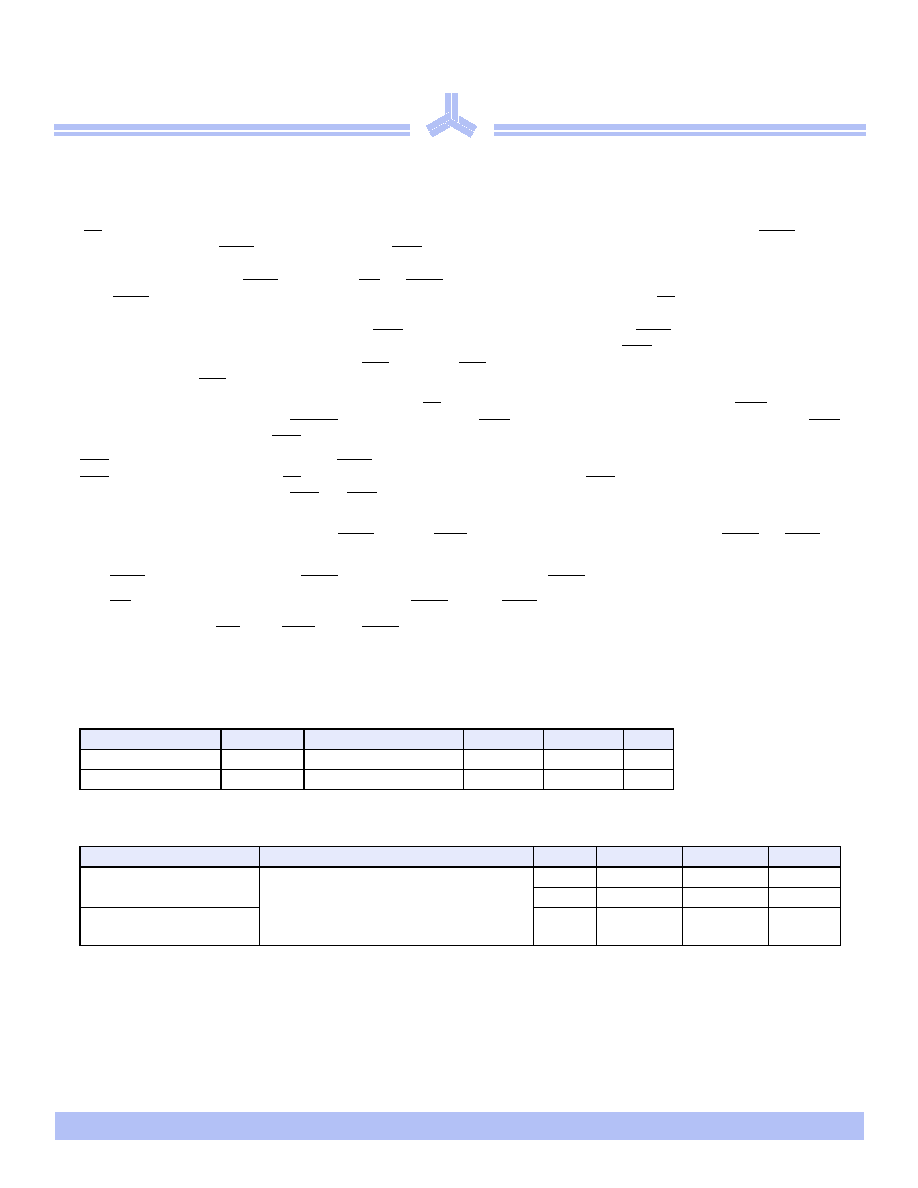- 您現(xiàn)在的位置:買賣IC網(wǎng) > PDF目錄295074 > AS7C25512PFD36A-133TQIN (INTEGRATED SILICON SOLUTION INC) 512K X 36 STANDARD SRAM, 3.8 ns, PQFP100 PDF資料下載
參數(shù)資料
| 型號(hào): | AS7C25512PFD36A-133TQIN |
| 廠商: | INTEGRATED SILICON SOLUTION INC |
| 元件分類: | SRAM |
| 英文描述: | 512K X 36 STANDARD SRAM, 3.8 ns, PQFP100 |
| 封裝: | 14 X 20 MM, LEAD FREE, TQFP-100 |
| 文件頁數(shù): | 14/19頁 |
| 文件大小: | 523K |
| 代理商: | AS7C25512PFD36A-133TQIN |

AS7C25512PFD32A
AS7C25512PFD36A
2/10/05, v. 1.2
Alliance Semiconductor
4 of 19
Functional description
The AS7C25512PFD32A/36A is a high-performance CMOS 16-Mbit synchronous Static Random Access Memory (SRAM) device
organized as 524,288 words x 32/36. It incorporates a two-stage register-register pipeline for highest frequency on any given technology.
Fast cycle times of 6/7.5 ns with clock access times (tCD) of 3.5/3.8 ns enable 166 MHz and 133 MHz bus frequencies. Three chip enable
(CE) inputs permit easy memory expansion. Burst operation is initiated in one of two ways: the controller address strobe (ADSC), or the
processor address strobe (ADSP). The burst advance pin (ADV) allows subsequent internally generated burst addresses.
Read cycles are initiated with ADSP (regardless of WE and ADSC) using the new external address clocked into the on-chip address register
when ADSP is sampled low, the chip enables are sampled active, and the output buffer is enabled with OE. In a read operation, the data
accessed by the current address registered in the address registers by the positive edge of CLK are carried to the data-out registers and driven
on the output pins on the next positive edge of CLK. ADV is ignored on the clock edge that samples ADSP asserted, but is sampled on all
subsequent clock edges. Address is incremented internally for the next access of the burst when ADV is sampled low and both address
strobes are high. Burst mode is selectable with the LBO input. With LBO unconnected or driven high, burst operations use an interleaved
count sequence. With LBO driven low, the device uses a linear count sequence.
Write cycles are performed by disabling the output buffers with OE and asserting a write command. A global write enable GWE writes all 32/
36 regardless of the state of individual BW[a:d] inputs. Alternately, when GWE is high, one or more bytes may be written by asserting BWE
and the appropriate individual byte BWn signals.
BWn is ignored on the clock edge that samples ADSP low, but it is sampled on all subsequent clock edges. Output buffers are disabled when
BWn is sampled lOW regardless of OE. Data is clocked into the data input register when BWn is sampled low. Address is incremented
internally to the next burst address if BWn and ADV are sampled low. This device operates in double-cycle deselect feature during read
cycles.
Read or write cycles may also be initiated with ADSC instead of ADSP. The differences between cycles initiated with ADSC and ADSP are
as follows:
ADSP must be sampled high when ADSC is sampled low to initiate a cycle with ADSC.
WE signals are sampled on the clock edge that samples ADSC low (and ADSP high).
Master chip enable CE0 blocks ADSP, but not ADSC.
The AS7C25512PFD32A/36A
family operates with a 2.5V ± 5% power supply for the device core (VDD). These devices are available in
a 100-pin TQFP package.
TQFP capacitance
* Guaranteed not tested
TQFP thermal resistance
Parameter
Symbol
Test conditions
Min
Max
Unit
Input capacitance
CIN*
VIN = 0V
-
5
pF
I/O capacitance
CI/O*
VOUT = 0V
-
7
pF
Description
Conditions
Symbol
Typical
Units
Thermal resistance
(junction to ambient)1
1 This parameter is sampled
Test conditions follow standard test methods
and procedures for measuring thermal
impedance, per EIA/JESD51
1–layer
θJA
40
°C/W
4–layer
θJA
22
°C/W
Thermal resistance
(junction to top of case)1
θJC
8
°C/W
相關(guān)PDF資料 |
PDF描述 |
|---|---|
| AS7C31024LL-100TC | 128K X 8 STANDARD SRAM, 100 ns, PDSO32 |
| AS8ERLC128K32SQ-250/883C | 128K X 32 EEPROM 3V, 250 ns, CQFP68 |
| AS8F1M32QT-90/Q | 1M X 32 FLASH 5V PROM MODULE, 90 ns, CQFP68 |
| ASD-FREQ-F-C-S | CRYSTAL OSCILLATOR, CLOCK, 1 MHz - 60 MHz, HCMOS/TTL OUTPUT |
| ASD1-FREQ-S | CRYSTAL OSCILLATOR, CLOCK, 1 MHz - 60 MHz, HCMOS/TTL OUTPUT |
相關(guān)代理商/技術(shù)參數(shù) |
參數(shù)描述 |
|---|---|
| AS7C25512PFD36A-166TQC | 制造商:ALSC 制造商全稱:Alliance Semiconductor Corporation 功能描述:2.5V 512K x 32/36 pipelined burst synchronous SRAM |
| AS7C25512PFD36A-166TQCN | 制造商:ALSC 制造商全稱:Alliance Semiconductor Corporation 功能描述:2.5V 512K x 32/36 pipelined burst synchronous SRAM |
| AS7C25512PFD36A-166TQI | 制造商:ALSC 制造商全稱:Alliance Semiconductor Corporation 功能描述:2.5V 512K x 32/36 pipelined burst synchronous SRAM |
| AS7C25512PFD36A-166TQIN | 制造商:ALSC 制造商全稱:Alliance Semiconductor Corporation 功能描述:2.5V 512K x 32/36 pipelined burst synchronous SRAM |
| AS7C25512PFS32A | 制造商:ALSC 制造商全稱:Alliance Semiconductor Corporation 功能描述:2.5V 512K x 32/36 pipelined burst synchronous SRAM |
發(fā)布緊急采購,3分鐘左右您將得到回復(fù)。